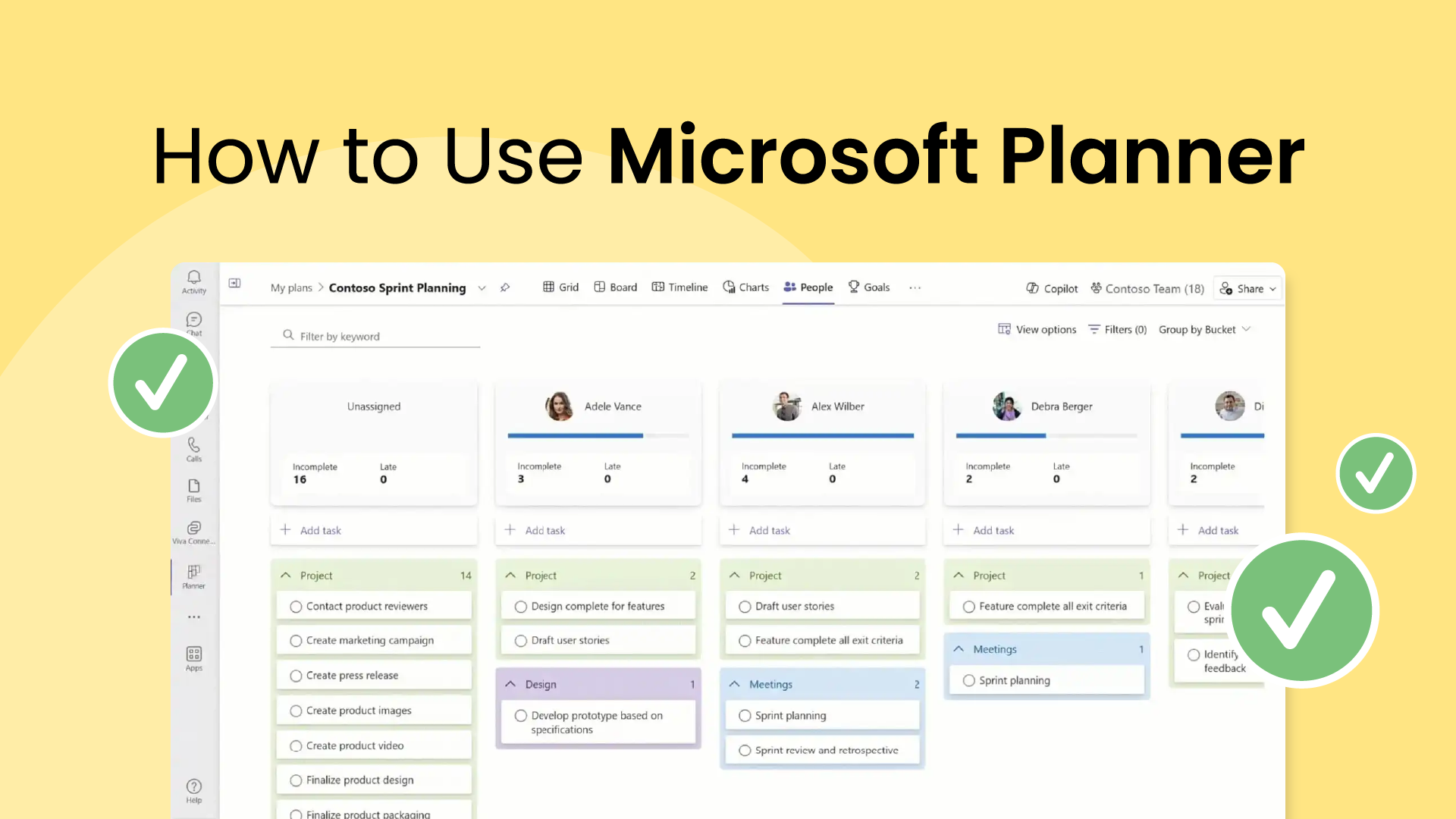Who doesn’t love a good gathering of the team? Team meetings can be a great way to build relationships, collaborate, share updates, and drive alignment across teams. The problem is teams are big, time is precious, and far too often the response to a problem is let’s get the team together to discuss.
What exactly is a team meeting? A team meeting is a scheduled gathering where team members come together to discuss work-related topics, share updates, collaborate on projects, and make decisions.
Team meetings suffer a lot of the same issues as status update meetings – they’re very often overscheduled, aren’t used to make decisions, and easily become duplicative across areas of the organization. With the average professional attending 17.1 meetings/week and only 2.2 hours a day on productive task work, it’s clear that meetings are overwhelming the workweek. It’s time for organizations to get their meetings in check.
In this guide, learn everything you need to know about team meetings.
Team meeting guide overview
- Team meetings industry data to know
- What should team meetings accomplish?
- 8 best practices for team meetings
- How to tell when you need a team meeting
- 6 types of team meetings
Team meetings industry data to know
Before we go any further, let's dig into team meetings by the numbers. As you can imagine, we know a lot about meetings – we've surveyed thousands of people about their meeting experiences, uncovering valuable insights into what makes meetings effective (or not!). Here are some of our findings:
- People average 14.8 hours in meetings/week (37% of their workweek)
- Annual cost of meetings per employee is $29,129
- People attend 6.7 team meetings/week
- 52.9% of team meeting are recurring
- Only 12.4% of company execs know how much time employees spend in meetings.
Employees want fewer meetings
Despite spending an average of 14.8 hours in meetings each week, a significant majority of employees feel this is too much. Here's the breakdown:
- 67.7% want to spend 10 hours or less in meetings/week.
- 20.0% want to spend 11-20 hours in meetings/week.
- 6.2% want to spend 21-30 hours in meetings/week.
- 6.2% want to spend over 31 hours in meetings/week.
Meetings are clearly necessary - 95% of professionals attend them regularly. But these numbers show how easy it is for them to become bloated, draining both productivity and company resources.
What should team meetings accomplish?
Okay, let's be honest. We've all been in those meetings that feel like a huge waste of time. But before you write off team meetings entirely, let's remember why they're important in the first place:
- Get everyone on the same page: Projects can get confusing fast! Team meetings make sure everyone knows what the big goals are, how their work contributes, and what the priorities should be.
- Collective brainpower: Two heads are better than one, and your whole team? Forget about it! Meetings are where you get different viewpoints, brainstorm solutions together, and generally tap into your team's full potential.
- Talk it out: Clear communication is the foundation of any good team. Meetings give you a dedicated space for updates, celebrating wins, and being honest about any issues before they become big problems.
- The human touch: Remote work is awesome, but sometimes you need that face-to-face connection. Meetings help build a sense of who your team members are, not just what they do.
- Making those big decisions: Team meetings give everyone a voice and help you reach better decisions by considering all the angles.
But remember, meetings aren't the solution to everything. You still need those one-on-ones and effective tools like CRM software to manage your projects and team communication efficiently. Think of meetings as a powerful tool for specific purposes. If your meeting doesn't do any of the things listed above, maybe it should just be an email!
8 best practices for team meetings
As you may have heard, it's become rather fashionable to hate on meetings.
Still, despite some of these dizzying stats we found, that's simply not the case. Sure, there are certainly bad meetings – but there are also good meetings too. Truth be told, if an organization eliminated meetings entirely, it'd be pretty difficult to function properly, if at all.
Shopify is a good example of this. In 2023, they announced a "calendar purge," in which they did just that: eliminated all meetings with more than three people in attendance. But while their rationale was to help employees focus and "improve our operational excellence," Clara Murray of Raconteur worries about the potentially harmful effects this can have on remote workers and company culture. She argues that while some are unproductive, virtual meetings are vital for remote workers to connect with colleagues and build a sense of community. Rather than outright bans, the focus should be on making meetings more efficient and valuable.
So what makes an effective team meeting? In order to justify taking time away from your team's busy schedule to meet, your team meetings should pass all of these best practice criteria:
1. Make decisions in these meetings
The number one checkpoint for every meeting is whether it’s actually oriented around making decisions. Each team meeting you schedule should have a real purpose with clear objectives that require getting people together to discuss. If the end result isn’t going to be actionable takeaways that move your projects and priorities forward, don't have the meeting.
2. Limit attendance
If you’re on the invite list, you should have a part to play in this meeting. Anyone who is not essential to the conversation should be spared from the meeting. The greater the number of meeting participants, the harder it is to have a productive discussion. So keep the attendee list small to improve the effectiveness of the meeting, and spare people who don’t need to be there so they can make better use of that time. Don’t worry about leaving them out, they don’t want to be stuck in a meeting that’s unrelated to their actual work.
3. Always use an agenda
We've all been there – stuck in a meeting that seems to drag on forever, with no clear purpose or direction. Always set an agenda so your team meetings don’t run off the rails. Each team meeting should have a dedicated person who creates the agenda, gathers agenda items from contributors, asks the team for input, and distributes it to attendees so everyone knows what to expect and prepare for the meeting. A great team meeting agenda will include links to any reports, documents, or meeting notes with detailed communication around what needs to be reviewed before the meeting.
4. Prepare for your part
There’s nothing worse than finally getting everyone together for a meeting only to find half the group is unprepared. This wastes every person in that meeting’s time since you will not be able to have the discussion you need to without the right information at the table. So make sure your team members know what’s expected from them and have access to the agenda before the meeting. If you have trouble finding time to prepare for your meetings, schedule focus time to make it a priority on your calendar.
5. Share status reports before the meeting
A successful team meeting should be focused on collaborating, not reporting what you’ve done since the last meeting. But people do need to know what progress has been made, so instead of wasting time in the meeting, ask all key participants to share their written status reports beforehand. This way, they can review it on their own time while dramatically cutting down on the length of these team meetings. With everyone up to speed beforehand, you can dive right into discussion and keep your meetings aligned to making real strategic decisions.
6. Change them from recurring to "as needed"
The other big consideration is how often are team meetings scheduled. If they don’t absolutely have to be recurring, which few actually do, then remove them from the calendar and schedule only as needed. A good indicator is how often are these meetings rescheduled and canceled? If you end up always canceling the next meeting because you don’t have anything new to talk about or you just have more important stuff to work on, they’re probably set too frequently. Even if you have a light agenda, ask yourself, can this meeting be an email? If they do need to be recurring, you can use AI tools like Smart Meetings to automatically schedule them at a time that's convenient for all attendees.
7. Keep team meetings on time
If you want to have a productive meeting, you need to also be respectful of everyone's time. And this means sticking to your scheduled start and end times. The time deadline gives your meeting a healthy sense of urgency to stay focused and on track so you can avoid running long. And if your agenda covers multiple topics, allocate time slots for each discussion point. This timeboxing technique guarantees all important items receive attention and prevents any one topic from dominating the entire meeting.
8. Encourage active participation
Effective team meetings thrive on active participation. While having a meeting leader to provide structure is important, avoid letting one voice dominate the conversation. Instead, create a collaborative atmosphere where each team member feels comfortable sharing ideas and solutions. Emphasize from the start that the meeting is a judgment-free zone where all questions and ideas are welcome. By creating this safe space, you encourage a wider range of perspectives and potentially uncover valuable insights that might otherwise stay hidden.
How to tell when you need a team meeting
It's easy to fall into the "meeting trap" – scheduling them by default whenever a problem comes up that you need help with. But not all team meetings are necessary – Here's how to know when you truly need one:
Useless meetings red flags
- "What are we even talking about?" A lack of agenda means wasted time and confusion.
- It should've been an email: If it's purely one person reporting information, skip the meeting.
- Crickets chirping: Low engagement is a sign that people don't find value in being there.
- We talked in circles... No decisions, no action plans? That's a problem.
Signs of a good meeting
- The meeting agenda is our guide: Everyone's prepared, and the discussion stays on track.
- Everyone gets a voice: Active participation leads to better ideas and buy-in for decisions.
- A space for solutions: We collaborate to overcome problems, not just talk about them.
- The next steps are crystal clear: We leave knowing who's doing what and by when.
The meeting pre-scheduling checklist
Before you schedule a meeting, ask yourself:
- What's the specific goal? Be clear on what you want to achieve.
- Are there better options? Could this be handled with an email, shared doc, or a quick one-on-one?
- Who's truly essential? Keep the attendee list tight for focused discussion.
- Does this need an immediate decision? If not, consider giving people time to reflect and respond.
6 types of team meetings
What are the common types of team meetings? Turns out, 89% of people attend one each week, but depending on your role, you may have quite a few eating up time on your calendar. Here are the most common types of team meetings to look for across your workplace schedule:
1. Team meeting (or staff meeting)
These meetings are with your primary team, and are used to share updates and make sure everyone is aligned on their tasks and priorities for the week.
The team lead will facilitate the meeting, distributing work, uncovering blockers, and sharing any new updates the team needs to know. Team meetings are almost always recurring, and often run long as large group discussions are easily sidetracked. You’ll find the entire team, the team leader, and program managers or operations personnel at a team meeting.
2. Cross-functional team meeting
This meeting is to ensure cross-functional alignment, usually as a reaction to a single incident, which results in a recurring meeting to ensure two groups are talking.
Cross-functional team meetings are used to resolve disagreements, increase awareness across groups, share updates or special presentations, and when used properly, to make decisions. While well-intended, these meetings easily become duplicative, overlapping discussions and topics with other meetings where both groups are present. They’re most often bets scheduled as needed vs. on a repeating schedule. You’ll find leaders from the cross-functional groups, the program managers or operations personnel, and an occasional guest star at a cross-functional team meeting.
3. Kickoff meeting
Used to launch a new project or initiative, the kickoff meeting sets the stage for success. This meeting aligns the project team (and sometimes the client) on goals, timelines, deliverables, and roles.
It's a chance to clarify expectations, build team rapport, and identify potential roadblocks. Kickoff meetings align the team right out of the gate on projects with multiple stakeholders, and can significantly improve project outcomes. You'll typically find the project team, project manager, key stakeholders, and potentially a client representative at a kickoff meeting.
4. Executive & leadership team meeting
Also known as the HIPPO meeting (highest paid person’s opinion), executive meetings are scheduled for the top leaders to make urgent, high-impact decisions on discussions that escalate up the chain of command.
The executive meeting is used to review key metrics or special presentations, analyze execution issues, and discuss and determine the strategy to move forward with. Attended by the leadership team and SVP and GVP leaders across multiple functions, though one of the most important participants is actually the program manager or operations personnel who are present. It’s their job to share honest insight and context around what’s happening on the ground floor, and how these decisions will impact the project and team.
5. Skip-level team meeting
This meeting is organized to get a department together for a general sort of discussion.
Often used to support team building, increase awareness around company initiatives, or to share updates or special presentations, skip-level team meetings are also used to discuss strategy and resourcing across the various levels within a department. You’ll find all members of the functional department, the program manager or operations personnel, and an occasional guest star present at these meetings.
6. All-hands meeting
This big company meeting is organized to share business updates, special presentations, and foster team building across the entire company. The all-hands presentation is generally led by senior leaders, followed by an interactive Q&A open to all employees. Depending on the size of your company, and if everyone is remote, this Q&A may be moderated and facilitated via online question submissions vs. the traditional hand-raising format.
The larger the company, the less interactive the Q&A tends to be, but leaders should do their best to reserve as much Q&A time as possible so employees are offered an adequate amount of time to voice their questions and concerns. As you’d expect, all employees at the company are invited to the all-hands meeting and expected, unless there’s some more urgent work that requires their immediate attention.
Transform your team meetings 🤝
And that’s the lowdown on team meetings! When used correctly, and only as needed, they can foster amazing discussions and generate real impactful decisions for the business. They can also cost you millions of dollars in lost productivity and result in higher rates of burnout, so if you still have recurring team meetings on your calendar, take the time to review if they’re really necessary. If you're curious to see how much time you really spend in meetings every week, check out the smart calendar tool for Google Calendar and Microsoft Outlook, Reclaim.ai, to see your calendar productivity stats and weekly report on your time management trends.
If you want to learn more about optimizing your meetings, check out this Smarter 1:1 Meetings blog post, and stay tuned for upcoming posts on brainstorming meetings and ideation sessions, operational reviews and staff meetings, and external meetings at busy organizations.


































